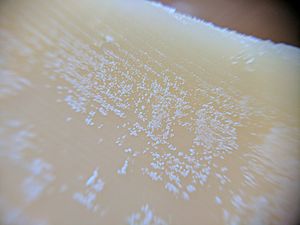Cheese crystals facts for kids
Cheese crystals are tiny, whitish, crunchy spots you sometimes see on the surface or inside of cheese. They are a natural part of many aged cheeses. Think of them like little sprinkles that add to the cheese's texture.
Cheese Crystals
What Are Cheese Crystals?
Cheese crystals are small, hard, white spots. They can feel a bit crunchy or gritty when you eat them. These crystals form as cheese gets older. They are a sign of a well-aged cheese. You can find them on the outside or inside of the cheese.
Where Do We Find Them?
These crystals are common in many types of hard, aged cheeses. Some popular examples include:
- Comté
- Aged Cheddar
- Parmesan (like Grana Padano)
- Pecorino Romano
- Old Gouda
Sometimes, in factory-made cheddar, these crystals are not wanted. But for many special cheeses, they are a good thing. They show the cheese has been aged properly.
What Are They Made Of?
Cheese crystals are made of different things. The most common type is calcium lactate. These crystals often appear on younger cheeses and on the surface.
In older cheeses, especially those like Grana Padano, you might find crystals made of amino acids. These are tiny building blocks of protein. The main amino acids found in these crystals are tyrosine, leucine, and isoleucine.
Basically, as cheese ages and dries out, some substances inside it become less able to dissolve in water. When this happens, they can form tiny crystals.



